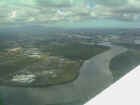The sky was
grey when we woke up. Due to the rush in getting out to the taxi, Flemming left the
video camera at the apartment. Fortunately he realized this before we took off, but
not before we had arrived at Selatar airport. So back I went in another taxi while
Flemming and Ray refueled and got the plane ready.
During the taxi ride, the rain came and it pelted down in typical
tropical fashion. I thought it would be best to wait until it subsided before taking
off, and therefore there was no point in rushing. But when I arrived at the airport,
it was just in the clear. Flemming phoned me on the mobile to say "Hurry up!
The storm is heading this way." So I ran to the plane and we took off in the
nick of time. The stormscope was lit up like a Christmas tree in the direction of
Singapore. But in the direction we were heading - North East - all was calm.
As expected from the forecasts and infrared satellite images, it was a pleasantly smooth
flight and we landed in Kuching, East Malaysia (Borneo) after just over 3 hours.
The next day we visited Baku National Park, home to the rare
proboscis monkey, about an hour out of Kuching by taxi and boat. There are several
trails of varying lengths there and we chose a three-hour circular walk taking us through
a variety of vegetation from lush, hot and steamy jungle to less lush, hot and dry. We saw
the proboscis monkey in a tree near park HQ soon after arrival - distinguished by its long
nose and pot belly. Then nearby we saw several of the more common long-tailed
macaque. About half way round the trail we met up with some Swedes. We asked
them whether they had spotted any pitcher plants, as we'd read that these strange jug-like
plants were to be found in the park. They said "No". Then
Flemming looked carefully at the plant he was standing next to, and lo and behold it was a
pitcher plant! These plants are like jugs with a lid that opens up as the plant
matures. There are several varieties of pitcher plant and the largest ones can hold
up to 2 liters of water. The jug holds a nectar that attracts unsuspecting
insects. Most of them drown in the nectar, but even if they manage to scramble
up the slippery walls of the jug, they meet with nasty spikey things on the rim.
We ate lunch at park HQ, carefully looking out for long-tailed
macaques that were quick to snatch not only one's food but also wallets, cameras,
etc. I bought some peanuts in their shells, wondering if the macaques would
bother to open them if they got their hands on them, or just eat them whole. It
didn't take long to get the answer to that question. I was only distracted for a
moment but the macaque swiftly scooped up both the peanuts bag and the rubbish bag
where I'd left the shells. It quickly realized which was the interesting bag because
it dropped the rubbish bag on the floor before making off. It didn't go far.
A short while later, I found it deftly removing the shells before shovelling the peanuts
into its mouth.
Back in Kuching, we found a restaurant with a great setting,
overlooking the river Sarawak, for our sundowners and dinner. We made up our minds
to do a sunset cruise on the river the following evening, which was to be our last in
Kuching. |
Click on image to
enlarge, click browser back to return 
Approach to Kuching over Sarawak river |

